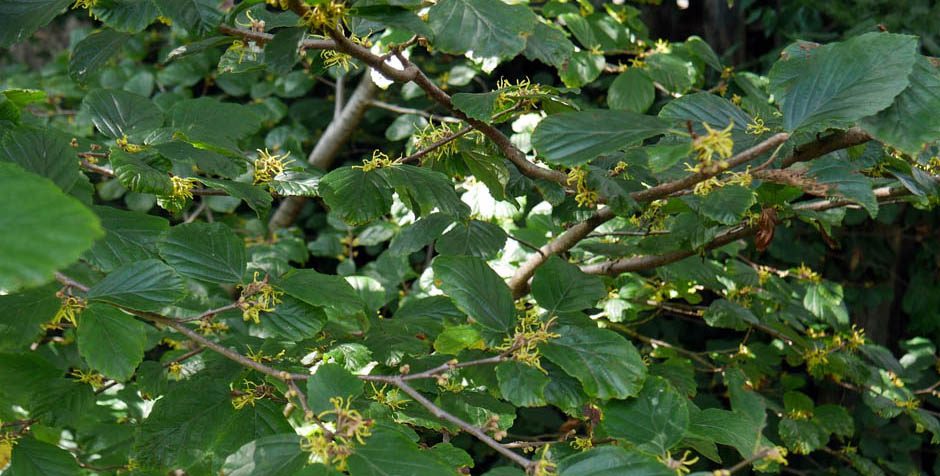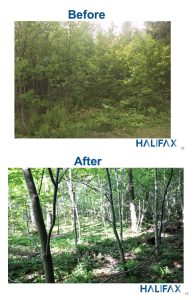| Subpages to nswidlflora.ca/Links/Point Pleasant Park |
The following information was provided by Alana Tapper, Superintendent Parks West, HRM Parks & Recreation on May 15, 2019
BACKGROUND
In September 2003, Hurricane Juan destroyed nearly 75% of the forest within Point Pleasant Park and due to the threat to public safety it was closed until June 2004. Although quite devastating at the time, it ultimately provided an opportunity to reset the focus of the park. In January 2005, public discussion began on the most effective ways to restore the park. Through a private donation the Municipality developed the Point Pleasant Park Comprehensive Plan, which was adopted by regional council in October 2008.
One of the core recommendations from the Comprehensive Plan called for a forest work plan to guide re-establishment of the parks Acadian forest. It outlines key objectives to re-establish and manage the forest within Point Pleasant Park. This plan was developed in conjunction with the Comprehensive Plan and was finalized in November of 2008.
The Forest Work Plan identifies the parks forest condition post-Hurricane Juan and provides recommendations to direct future growth and meet several of the goals outlined in the Comprehensive Plan. It gives special consideration to archaeological and wetland areas, as well as providing management options for dealing with non-native invasive species. The overall theme of the Comprehensive Plan can be summarized by “the park forest must be managed for resilience to future disturbance agents”.
DISCUSSION
Since adoption of the Forest Work Plan adoption in 2008, several forest restoration projects have been completed:
– From 2008 – 2009 over 100,000 seedlings have been planted in areas where trees were not naturally re-growing. This exceeds the number of trees that were lost during Hurricane Juan in Point Pleasant Park.
– In 2010, several large trees were removed from fortifications to help reduce further damage to historical assets and to prepare for restoration projects.
– Trials for removal of invasive plants were conducted and information gained from those trials will be used to develop control strategies over the next 10 years. Species targeted were multiflora rose (Rosa multiflora) and Japanese knotweed (Fallopia japonica).
In areas affected by Hurricane Juan, natural regeneration of the forest has been impressive. This regeneration has reached a point where intervention is required to thin out overcrowding allowing trees to become more open in their growth habit and to be more wind firm. A secondary benefit of this thinning, is to eliminate exotic and invasive tree species. In commercial forestry, this practice is known as pre-commercial thinning, but for our purposes it is best referred to as stand enhancement thinning (SET).
Stand enhancement thinning (SET) will be done in two phases:
Phase 1 – will space the trees 2.5 – 3.0 meters apart while incorporating the removal of all non-native invasive species. Trees such as red maple that have regrown numerous stems from suckering will be thinned down to 3 – 5 main stems and will require successive thinning in future years.
Phase 2 – will commence approximately 5 years following Phase 1. This thinning will focus on the trees that were reduced to 3 – 5 stems, and will thin to a final single dominant stem. Any non-native invasives that may have been missed or are re-growing will also be targeted.
Other objectives that can be completed within the scope of work include:
– Selective removal of mature invasive trees such as Norway Maple and Scots Pine.
– Selective removal of trees to protect fortifications and maintain historical view planes.
– Removal of highly invasive multiflora rose and Japanese knotweed.
– Reclamation of forest stands through removal of crusher dust migration into forest areas.
PROJECT DETAILS
Develop a detailed 10 year plan for the following five projects:
1. Stand Enhancement Thinning (SET) – GPS areas, measure height stratums, produce maps and amass information for tendering. Develop methodology, i.e. Goal is a 50-50 ratio of softwood to hardwoods on flat surfaces, 30-70 ratio of softwood to hardwoods on south facing slopes, spacing factor, list of desired species, buffers around wetlands. This work can be completed using internal and external resources.
2. Reinstatement of one Heather stand – by removing woody and herbaceous materials so area in made up entirely of heath and heather species. This work can be completed using internal resources.
3. Invasive tree removal – GPS locations, create a current map of mature invasive trees and develop a 10 year schedule for their removal. Plan identifies 19 different native trees and 15 non-native tree species. This can be done using internal resources..
4. Tree removal from fortifications – Develop a current map of trees on fortifications requiring removal and develop plan. Revegetation may be required. This can be done using internal resources.
5. Invasive plant removal – Develop prescriptions for removal of Japanese Knotweed and multiflora rose. Disturbed areas will have to be covered with mulch and re-planted. Knotweed may require complete excavation and removal.
6. Removal of crusher dust – Update existing map, develop a scope of work and schedule for removal and reinstatement of vegetation.
Also view:
| Point Pleasant Park Forest Work Plan PDF of slide presentation by Stephen Rice, June 20, 2019. Slides decsribing the forestry work in point form. Amongst them, the followingThe Forestry work plan – The Forest Work Plan outlines the existing condition of the Park’s forest stands and provides recommendations as to the various interventions needed to meet the intent of the Comprehensive Plan. – The 5 main interventions identified are: – fill planting, – competition control, – tree removal from fortifications, – mitigation of crusher dust, – invasive vegetation management. – The park forest must be managed for resilience to future disturbance agent Tree Response to Thinning
Methods/ Specifications List of trees to be removed Acadian Forest Species to be left |
POINT PLEASANT PARK ADVISORY COMMITTEE MINUTES June 20, 20199.1.2
HRM Document. From that document: “Forestry Work Project Update Stephen Rice, Supervisor Major Parks, provided a presentation to the Committee, a copy of which is on file. The Comprehensive Plan provides a forest framework with the goal of achieving a resilient and sustainable Acadian forest. The forest work plan sets 5 operational objectives: fill planting, competition control, tree removal from fortifications, mitigation of crusher dust and invasive vegetation management. A forest thinning project will take place this fall to address some of these objectives. Rice reviewed how the ecosystem responds to a thinning program and how the number of trees to be thinned was calculated. This program will be done over 3 years, 10 hectares a year. The 10.63 hectares to be completed this year was broken down into 5 areas. The methods and specifications being used were reviewed along with a list of tree species that would be removed as well as a hierarchy of Acadian tree species. Rice shared photos of areas of forest before and after thinning. Rice confirmed that they will be working very closely with the contractor throughout the project. The Committee indicated that some thinning around the fortifications is also necessary to restore view lines, particularly the overgrowth at the North West Arm Battery. It was agreed that a program needs to be developed with set standards for these areas. The Committee encouraged staff to share this information with the public as they found it very informative and that it would address any misunderstanding that is presently out there. Rice noted that there is an HRM Park Naturalization Strategy which will feature this project and provide updates and suggested that corporate communications could also issue a public service announcement. They also have some University students interested in measuring the progress of this initiative.”


